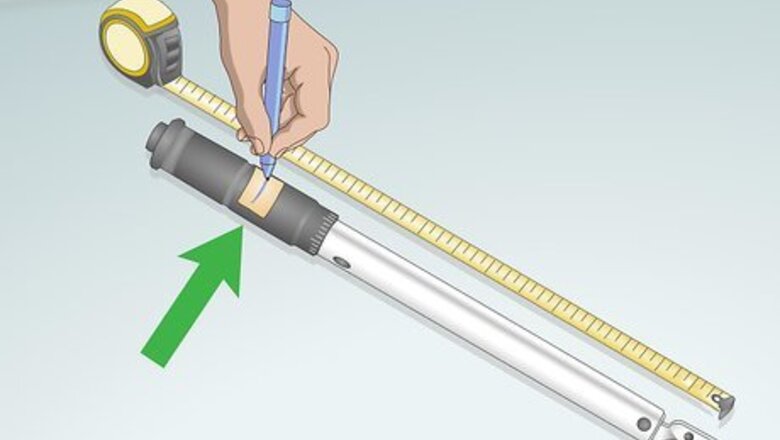
views
Testing the Calibration of the Torque Wrench
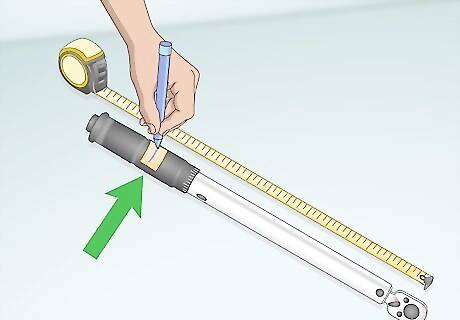
Measure from the square drive to the handle. The square drive is the end of the torque wrench you’d attach a socket to. For the sake of simplicity, use whole inches rather than using any fractions. Mark the point you measured to on the handle and record the distance on a piece of paper for you to come back to later. Set the paper aside in a safe space until you need it. Because 24 inches (61 cm) is a common length for most torque wrenches, it will serve as the measurement for further steps.

Secure the square drive in the vice. Orient your bench vice so you can place the square drive of the torque wrench into and have the handle extend out, away from the table or bench. Then insert the square drive into the vice and tighten it until it’s secure. Be careful not to overtighten the vice and damage the square drive on the torque wrench. Make sure only the square drive itself is caught in the clamp, so the wrench can move under the weight you apply.
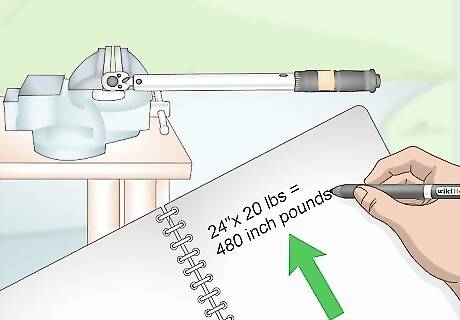
Calculate the appropriate setting for your weight. The equation is: handle distance times weight divided by 12. In order to determine the right setting for the torque wrench, multiply the distance you measured in step 2 by the 20 pounds you will be using for your weight. That comes out to 480 inch-pounds (24 inches times 20 pounds) which equates to 40 foot-pounds (480 inch-pounds divided by 12). If you're working with metric units, start by converting the weight to Newtons. To do this, multiply the number of kilograms by 9.807. In this example 9.07 kg x 9.807 = 88.94949 Newtons. Then, multiply the number of Newtons by the length in meters: 88.94949 Newtons x 0.6096 meters = 54.2 Newton meters. To convert foot-pounds to Newton meters, multiply by 1.35582. For this example, 40 foot-pounds is equal to 54.2 Newton meters. Be sure to use the correct distance and weight figures. If your wrench is a different size or you’re using different weights, your figures will be different.
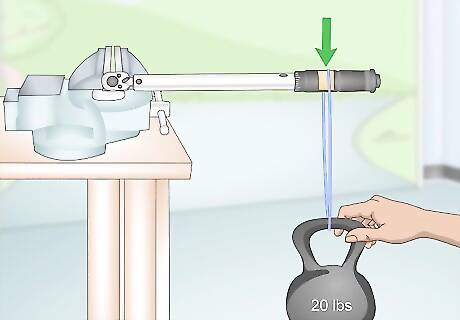
Hang the weights from the handle of the wrench. Tie the rope to the weight and make a loop that you can hang from the handle of the torque wrench where you made your mark in step 1. Make sure the length of rope is short enough that the weight won’t touch the ground once you hang it. Do not securely tie the weight to the wrench. Instead, simply hang it. Be sure nothing is in the way of or supporting the weight as it hangs.
Correcting Torque Wrench Calibrations
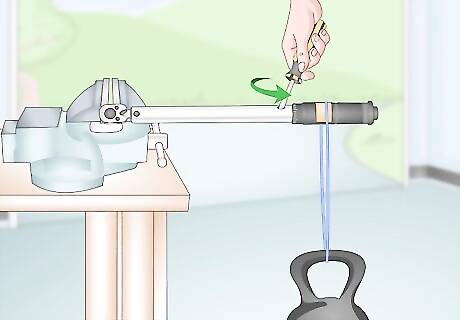
Adjust the torque wrench using the weight. You can usually adjust the spring tension in a torque wrench by turning a screw located midway up the wrench’s handle with a screwdriver. Hang the 20 lb (9.1 kg) weight from the torque wrench at your first mark and see if it clicks. If it doesn’t, tighten the spring by turning the screw clockwise, then lift the weight and lower it again to test it. Repeat this process until the torque wrench clicks using the known weight. Be sure to lift the weight off the wrench and lower it again to test for clicking each time.
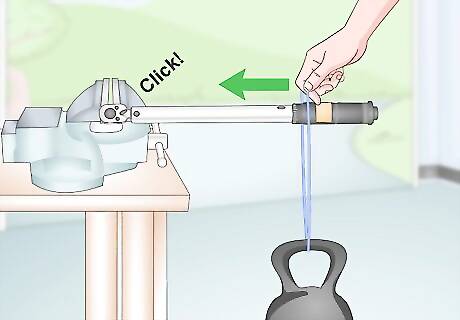
Move the weights up the handle if you hear a click. Listen for a click from the torque wrench as you hang the weight from the marked point on the handle. If you hear one, lift the weight off the handle and set it down again further up the neck, moving toward the head of the wrench. Keep repeating this process until you stop hearing the click. Be sure to lift the weight off and set it down again each time. Do not slide it up the handle.
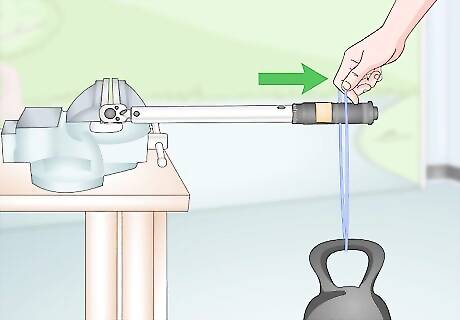
Lower the weights if you don’t hear a click. If you don’t hear a click from the torque wrench as you place the weight on it, move the weight down the handle of the wrench until you do hear one. Start by moving the weight an inch or so at a time. It’s okay to move up and down the handle of the wrench more than once as you look for the point in which it starts to click.
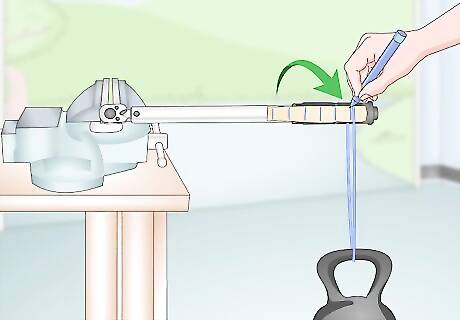
Mark the point of transition. Once you find the point in which the handle transitions from clicking to not, mark it on the wrench with your pen. Be sure to mark the point exactly, so you may need to make multiple attempts at identifying where it is by moving the weight up and down the handle. The part of the handle where it begins or stops clicking is called the transition point.
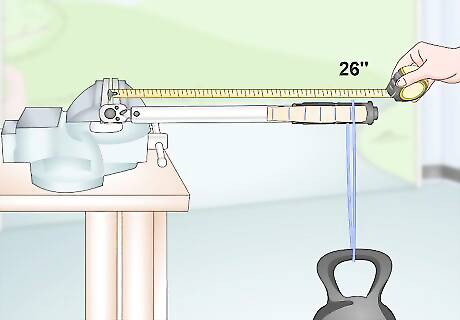
Measure from the square drive to the point of transition. Use the measuring tape to find the distance from the square drive to the transition point you identified using the weight. Record that number on a piece of paper and set it aside. A measurement of 26 inches (66 cm) will be used for this example, but yours may be different. Be careful not to confuse this number with the figure you recorded in step 2. You may want to test finding the transition point more than once to be sure you have the correct number.
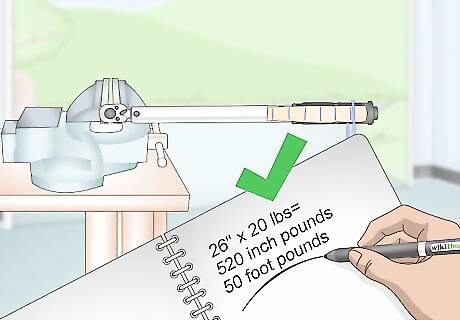
Calculate the applied torque. If the transition point of the torque wrench with 20 pounds was at 26 inches, for instance, multiple that by 20 pounds to determine the amount of torque actually applied: so 26 inches times 20 pounds equals 520 inch-pounds, or 43.33 foot-pounds (520 divided by 12 inches ). The equation is the same as before: measurement length times weight, divided by 12. If you're using metric units, convert the weight to Newtons (kg x 9.807), then multiply the number of Newtons by the length in meters: 9.07 kg x 9.807 = 88.95 Newtons. 88.95 Newtons x 0.6604 meters = 58.74 Newton meters.

Correct for the difference you identify. If you are unable to adjust the torque wrench, you can still use it pretty accurately if you adjust the settings you use on the wrench to compensate for the difference. Divide your first measurement by the transition point (in this case, 24 divided by 26, which equals 0.923). Whenever you need to use the torque wrench, multiply the correct torque by this number. Multiplying your intended torque by the difference will give you the correct setting for your specific torque wrench. This solution can keep you working, but the wrench will still need to be calibrated.
Maintaining the New Calibration

Return the scale to zero after each use. While all torque wrenches will need to be calibrated regularly, you can prolong the life of each calibration by returning the setting of the torque wrench to zero after each time you use it. The strain on the internal spring can cause the calibration to drift if not left on zero.
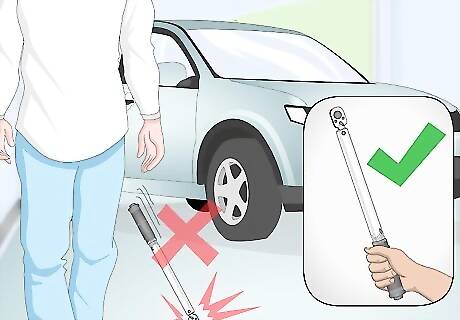
Keep a tight grip on the torque wrench. Dropping your torque wrench onto any sort of hard surface can instantly affect the tool’s calibration. Be sure to set the torque wrench down in safe places to avoid letting it fall, and never use a torque wrench in place of a hammer or lever. Banging a torque wrench around will immediately affect its calibration. Torque wrenches have even been known to break when dropped.
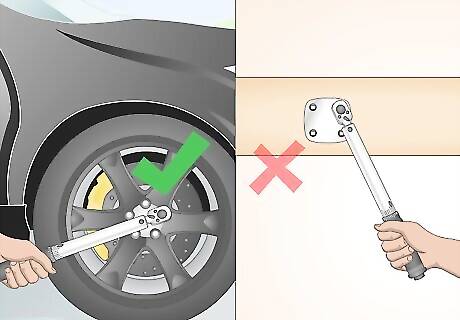
Use the torque wrench only for appropriate tasks. Because a torque wrench looks similar to a breaker bar, people often make the mistake of using them interchangeably. A torque wrench should only be used in instances that require specific torque specifications. Using it for other jobs can affect its ability to maintain its calibration. Using a torque wrench in place of a breaker bar or different type of wrench can affect calibration or even damage the wrench. Treat the torque wrench as a speciality tool, rather than an all-purpose one.
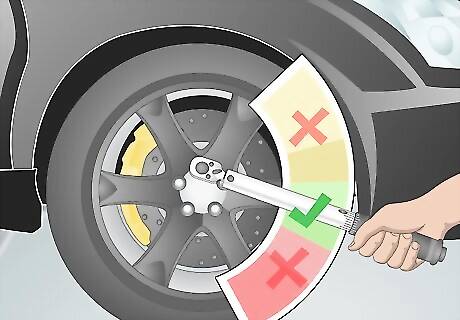
Stay within the torque wrench’s upper and lower limits. Exceeding the prescribed limits of a torque wrench can damage it, or might affect the wrench’s calibration. Many torque wrenches have clearly indicated upper and lower torque tolerances. Never use the wrench for jobs that require more or less torque than your wrench is rated for. Exceeding the maximum torque rating for a wrench may even break it. If you damage your torque wrench, it may not be able to hold a calibration any longer.
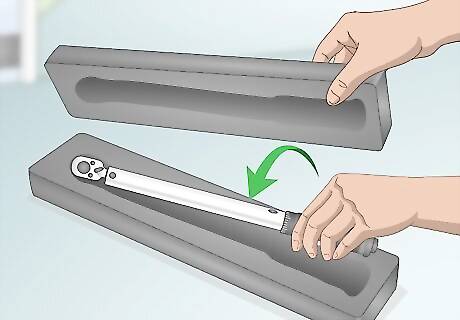
Store your torque wrench in its case and by itself. Because torque wrenches can be so easily affected by impacts and even temperature changes, it’s best that you store your torque wrench inside its protective case and separate from other commonly used tools. Store the torque wrench low, so if it does fall, it won’t be far enough to cause any significant damage to the calibration. Keep the torque wrench in a climate controlled area. Big shifts in temperature or humidity can affect its calibration.











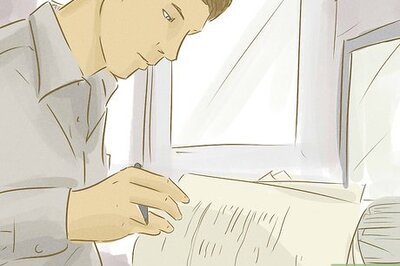







Comments
0 comment